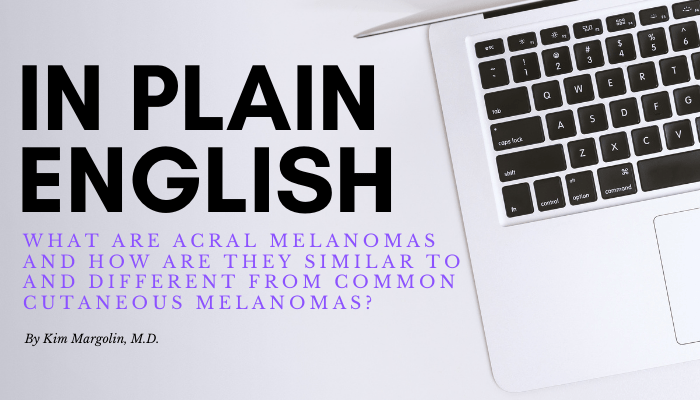In Plain English: What are Acral Melanomas and How are They Similar to and Different from Common Cutaneous Melanomas?

By Kim Margolin, M.D.
The definition of “acral” is “topmost” or “highest,” and this term refers to a body part that is furthest from the center, i.e., at the ends of the arms or the legs. When used to describe melanomas, acral or acral lentiginous (for the rest of this article, acral will be used) refers to a melanoma that arises either in the skin of the palms or soles or in the region around or under the fingernails or toenails. Acral melanomas make up only 2-3% of all melanomas and are often diagnosed at a much more advanced stage than common cutaneous melanomas. This delay in diagnosis and initial treatment is because acral melanomas may grow slowly under the nail and look similar to a nail injury (a black-brown spot under the nail with or without elevation), or they may grow unnoticed on the sole of the foot. Patients are rarely aware of this type of melanoma, and many doctors are also unfamiliar with its appearance and how to make the diagnosis or when to refer the patient for specialized evaluation and care.
When patients with acral melanoma are compared with patients who have common cutaneous melanoma at identical stages and with identical features such as thickness, presence or absence of enlarged lymph nodes, and ulceration (breaking through the top layer of skin), those with acral melanoma have often been reported to have a more unfavorable prognosis; however, not all reports agree, and a recent series from Korea showed better prognosis for acral melanoma than for those with an identical primary on the trunk. Light-skinned people and people of darker-skinned groups have about the same incidence of acral melanomas. However, darker-skinned people rarely get common cutaneous melanoma, so they seem to have more acral melanomas.
Acral melanomas may be particularly challenging with regard to initial diagnosis and dermatologic and surgical management not just because many doctors are unfamiliar with their appearance and may overlook them, but also because biopsy of a dark spot under the nail may be difficult and painful, sometimes requiring removal of the nail. Similarly, amputation of part of all of the finger or toe is sometimes required to remove the entire tumor with adequate tumor-free margins, which are critical. For large melanomas on the palm or sole, complex surgical reconstruction may be necessary, and healing may be slow and painful. Finally, the value of the sentinel lymph node biopsy (SLNB) may be lower in acral melanoma than in common cutaneous melanoma. This is because SLNB is best for detecting and removing melanoma only in the lymph nodes but nowhere else. However, acral melanoma also has a tendency to spread through blood vessels—bypassing the lymphatic passages and lymph nodes—to organs like the liver and lungs. For this reason, it may be necessary to incorporate CT scans and PET scans into the follow-up of all acral melanoma patients in order to detect any sign of spread at a time when the patient has no symptoms and is in good shape to respond to treatment.
Another challenge in acral melanoma is related to current treatment limitations. Acral melanoma’s distinct pattern of mutations is different from that of common cutaneous melanoma—specifically, the BRAF v600 mutation occurs in about half of common cutaneous melanomas but only about 10% of acral melanomas. This difference is a problem because one major successful therapy for common cutaneous melanoma with the BRAF mutation is targeted drug combinations with a BRAF inhibitor and a MEK inhibitor (discussed in detail in “In Plain English”: What is a “Triplet,” and Why Does it Matter in Melanoma?), and they simply won’t work on 90% of acral melanoma patients. A small percentage of acral melanomas (10-20%) carry a different mutation (kit) for which there are treatments with modest and temporary benefit—oral drugs that are used primarily for patients with a type of chronic leukemia and a rare gastrointestinal sarcoma. The other types of genetic alteration found in most acral melanomas are loss of parts of certain genes that ordinarily suppress malignant behaviors as well as exchanges of parts of chromosomes that lead to more malignant behavior in tumor cells. To date, we have no drugs that work against acral melanoma by targeting these particular genetic alterations, so we rely on immunotherapy, which doesn’t work by interrupting single malignant pathways but rather by recognizing abnormalities on the surface of melanoma cells that look foreign and killing those cells.
Understanding mutations inform us not only about possible targeted therapies but also about immunotherapy. Common cutaneous melanomas have many mutations of the type caused by chronic sun damage—these are the types of genetic alterations rarely found in acral melanomas. These types of chronic sun damage mutations have no effective targeted drugs but may make the cells more sensitive to the immune system because they cause alterations in many proteins that make the melanoma cell appear foreign to the immune system. The commonest ones include—but are not limited to—NRAS, NF1, NOTCH2, PTEN, MDM2, and CDK4. While their functions are too technical for the purposes of this article, they are listed here to emphasize the targets that scientists are currently working to find drugs for, if not in melanoma, at least in some other tumor types. Many drugs have been tried that seem to fit the genetic mutation or alteration found in a particular patient’s acral melanoma. However, the vast majority of melanomas feature more than one type of mutation, and even the best drug that seems to target the predominant mutation may fail to work because the cell has other mutations that allow the tumor to “escape” from being killed by the targeted drug. Likewise, combining two drugs to overcome this form of resistance is often either ineffective or excessively toxic and cannot be tolerated.
The mainstay of treatment for acral melanoma is now immunotherapy—just the same as common cutaneous melanoma, although with much less data and therefore more variable reported rates of patient benefit. The history of various immunotherapy approaches is briefly outlined here: While some immunotherapy drugs were used as long ago as the 1980s, those drugs tended to have multiple and severe toxicities at doses that were effective, and their effectiveness benefited only a small percentage of patients. Throughout the 1990s and early 2000s, there was a dry spell in the treatment of melanoma, as very few advances were made in immunotherapy, none in chemotherapy, and none yet in targeted drugs until 2011. In around 2005, a whole new class of highly potent immunotherapies, the immune checkpoint blocking antibodies, was developed. These drugs have far fewer toxicities and a much higher rate of benefit, even producing remissions (sometimes very long) in patients with widely metastatic melanoma. With these drugs, melanoma patients for the first time could anticipate the possibility of a long remission that could be equated to cure—considered if there is no relapse over five to ten years. These immune checkpoint blockers—starting with ipilimumab (Yervoy) in 2011, followed by pembrolizumab (Keytruda) in 2014 and nivolumab (Opdivo) in 2015, were initially approved by the US FDA in advanced (metastatic, previously incurable) melanoma (including acral) and subsequently in adjuvant treatment—given to patients whose melanoma and associated lymph nodes were surgically removed but the patient was still at high risk of relapse, a risk that could be lowered with immunotherapy. Acral melanoma patients generally comprised only a tiny percentage of patients in the important trials that demonstrated the power (and risks) of these drugs. Therefore, even though we can state that the outcomes of these therapies for patients with acral melanoma are similar to common cutaneous melanoma, the estimates for benefit and duration of remission must be considered less precise due simply to the increased variability when the numbers are low. So far, there has been no convincing association of any particular melanoma mutation—whether in common cutaneous melanomas or acral melanomas—with the outcome of immunotherapy, which is directed toward groups of mutations from the sun rather than single, shared mutations like BRAF.
The principles of studying new drugs in rare tumors are based on the discovery of new molecular pathways and new drugs that block the functions of these proteins. Molecular pathways are interactions among proteins inside of the cancer cell that leads to the malignant behavior of that cell, including proliferation faster than normal cells, lifespan longer than normal cells, and ability to spread and live in other organs leading to the eventual death of the patient. When a single pathway is responsible for all of those characteristics in a particular malignancy (the example in melanoma being BRAF v600 mutations), it is called a driver mutation. So far, this scientific approach has led to the discovery of many new pathways across the spectrum of solid tumors and blood malignancies in adults and, to a lesser extent, in children. There is now a deep and growing understanding of many such molecular drivers and additional genetic alterations in melanoma, including the patterns of genetic alterations most characteristic of acral melanoma. However, only one pathway (the one that is activated by the BRAF mutation) is targetable with approved drugs, the BRAF plus MEK inhibitor pairs vemurafenib (Zelboraf) and cobimetinib (Cotellic), dabrafenib (Tafinlar), and trametinib (Mekinist), or encorafenib (Braftovi) and binimetinib (Mektovi), and this mutation is rare in acral melanoma. As mentioned above, the identification of a kit mutation in some melanomas (including acral,) may make them sensitive to killing by one of the kit-blocking drugs used for gastrointestinal sarcoma and chronic myeloid leukemia, but these drugs are not officially approved for any subset of melanoma patients and do not have a high rate of efficacy or a long term benefit in the few studies that have been done. What will help patients with acral melanoma will come from a greater understanding of genetic alterations and molecular pathways specific to this particular type of melanoma? This understanding will be coupled with the discovery or development of new drugs that very effectively and safely block these pathways and thus shut down the entire survival program for acral melanomas.
In closing, the pace of developments in understanding the molecular and immunologic characteristics of melanoma and all of its subsets has been astounding over the last several years, and a large number of drugs and immunotherapies are under investigation for those groups who don’t benefit from the treatments currently available. The future looks promising for patients with acral melanoma, starting with primary care physicians and dermatologists improving their ability to recognize, diagnose and provide optimal initial therapy, and moving on to the laboratory scientists and translational and clinical investigators designing trials of new strategies for patients according to the precise characteristics of their tumor.

Kim Margolin, M.D.
Dr. Margolin is a medical oncologist specializing in melanoma and other skin cancers. She worked at City of Hope for 30 years and also held faculty positions at the Seattle Cancer Care Alliance/University of Washington and at Stanford University. Among her academic achievements were long-term leadership of the Cytokine Working Group, leadership involvement in the Cancer Immunotherapy Trials Network, participation in the Southwest Oncology Group’s Melanoma Committee, and many positions in the American Society of Clinical Oncology and the Society for Immunotherapy of Cancer. Dr. Margolin has reviewed grants for many cancer-related nonprofit organizations and governmental agencies. She has also served as a member of the Oncology Drugs Advisory Committee to the FDA, the American Board of Internal Medicine’s Medical Oncology certification committee, and the Scientific Advisory Committee of the European Organization for the Research and Treatment of Cancer.
Dr. Margolin collaborates with AIM at Melanoma to write the monthly “in Plain English” to provide timely updates on new developments for patients, caregivers, and other individuals with an interest in medical advances in melanoma.






